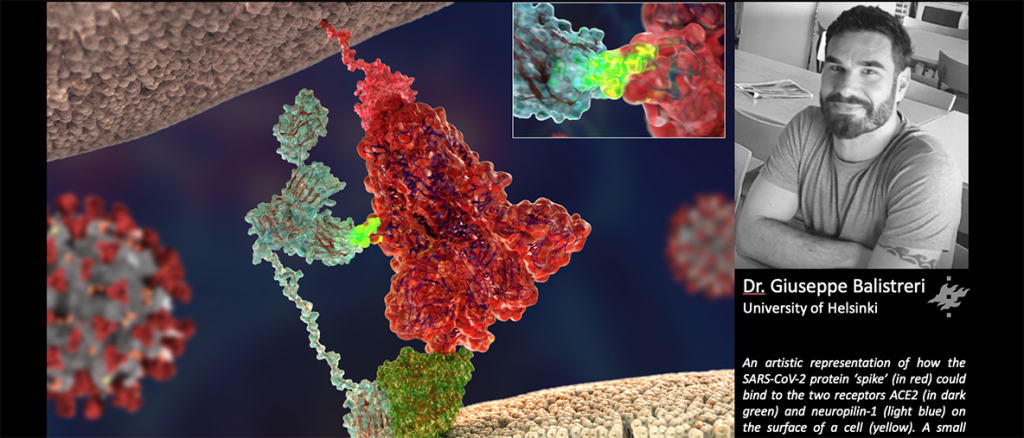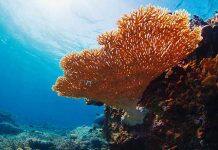To efficiently infect human cells, SARS-CoV-2, the virus that causes COVID-19, is able to use a receptor called Neuropilin-1, which is very abundant in many human tissues including the respiratory tract, blood vessels and neurons. The breakthrough discovery was made by a German-Finnish team of researchers led by neuroscientists Mika Simons, Technical University of Munich, Germany and virologist Giuseppe Balistreri, University of Helsinki, Finland.


Why is the new coronavirus so infectious?
“That SARS-CoV-2 uses the receptor ACE2 to infect our cells was known, but viruses often use multiple factors to maximize their infectious potential” says Dr. Giuseppe Balistreri, head of the research group Viral Cell Biology at the University of Helsinki involved in the study. “Unlike the main receptor ACE2, which is present in low levels, Neuropilin-1 is very abundant in the cells of the nasal cavity. This is a strategically important localization possibly contributing to the efficient infectivity of this new coronavirus, which has caused a major pandemic, spreading rapidly around the world”, Balistreri explains.
SARS-CoV-2 infects also the upper respiratory system including the nasal mucosa and consequently spreads rapidly. “This virus is able to leave our body even when we simply breath or talk”, Balistreri adds. “The starting point of our study was the question why SARS-CoV, a coronavirus that led to a much smaller outbreak in 2003, and SARS-CoV-2, spread in such a different way even if they use the same main receptor ACE2”, explains Ravi Ojha, a young researcher in the Balistreri’s team, and one of the main contributors of the study.
A mysterious extra key on the virus surface
To understand how these differences can be explained, in collaboration with the team of Professor Olli Vapalahti, University of Helsinki, the researchers took a look at the viral surface proteins, the spikes, that, like hooks, anchor the virus to the cells. Balistreri reveals that “when the sequence of the SARS-CoV-2 genome became available, at the end of January, something surprised us. Compared to its older relative, the new coronavirus had acquired an ‘extra piece’ on its surface proteins, which is also found in the spikes of many devastating human viruses, including Ebola, HIV, and highly pathogenic strains of avian influenza, among others. We thought this could lead us to the answer. But how?”
The turning point of the research was when Ari Helenius, Professor emeritus at the ETH Institute in Zurich, Switzerland, and a former mentor of Balistreri, discussed the matter with two colleagues, Estonian cancer biologists Professor Tambet Teesalu ,University of Tartu, Estonia and Professor Erkki Ruoslahti, University of California, the USA. Professor Teesalu knew that the same sequence acquired by the new coronavirus is also present in certain cellular proteins and hormones that use Neuropilin receptors. Already in 2009, Dr Teesalu and co-workers had suggested that “perhaps, similar to our hormones, viruses that have this key can use neuropilin receptors to gain access into human tissues”.
Together, the team of scientists looked at whether neuropilins were important for infection by SARS-CoV-2. The experiments performed by Simons, Teesalu and Balistreri teams, together with colleagues from the University of Queensland, Australia, and other research institutions now¨´support this hypothesis. Interestingly, an independent team of scientists at the University of Bristol , UK, has obtained similar results and confirmed that the virus spike binds directly to neuropilin-1 (Ref. DOI: 10.1126/science.abd3072).
New antiviral strategy in making
By specifically blocking neuropilin-1 with antibodies, the researchers were able to significantly reduce infection in laboratory cell cultures. “If you think of ACE2 as a door lock to enter the cell, then neuropilin-1 could be a factor that directs the virus to the door. ACE2 is expressed at very low levels in most cells. Thus, it is not easy for the virus to find doors to enter. Other factors such as neuropilin-1 might help the virus finding its door”, says Balistreri.
Since disorders in smelling are among the symptoms of COVID-19 and neuropilin-1 are known to be localized in the cell layer of the nasal cavity, the scientists examined tissue samples from deceased COVID-19 patients. “We wanted to find out whether cells equipped with neuropilin-1 are really infected by SARS-CoV-2, and found that this was the case, says Mika Simons, Professor of molecular neurobiology at the Technical University of Munich and co-leader of the study.
Additional studies in mice suggested that neuropilin-1 enables transport from the nasal mucosa to the central nervous system. The animals were administered tiny, virus-sized particles via the nose. These nanoparticles were chemically engineered to link to neuropilin-1. It turned out that after few hours the nanoparticles reached neurons and capillary vessels of the brain, whereas control particles without affinity for neuropilin-1 did not. “We could determine that neuropilin-1, at least under the conditions of our experiments, promotes transport into the brain, but we cannot make any conclusion whether this is also true for SARS-CoV-2. It is very likely that this pathway is suppressed by the immune system in most patients”, Simons says.
Balistreri cautiously concludes “it is currently too early to speculate whether blocking directly neuropilin could be a viable therapeutic approach, as this could lead to side effects. This will have to be looked at in future studies. Currently our laboratory is testing the effect of new molecules that we have specifically designed to interrupt the connection between the virus and neuropilin. Preliminary results are very promising and we hope to obtain validations in vivo in the near future.”
Original publication
Neuropilin-1 facilitates SARS-CoV-2 cell entry and infectivity, Ludovico Cantuti-Castelvetri et al., Science (2020), DOI: 10.1126/science.abd2985








































